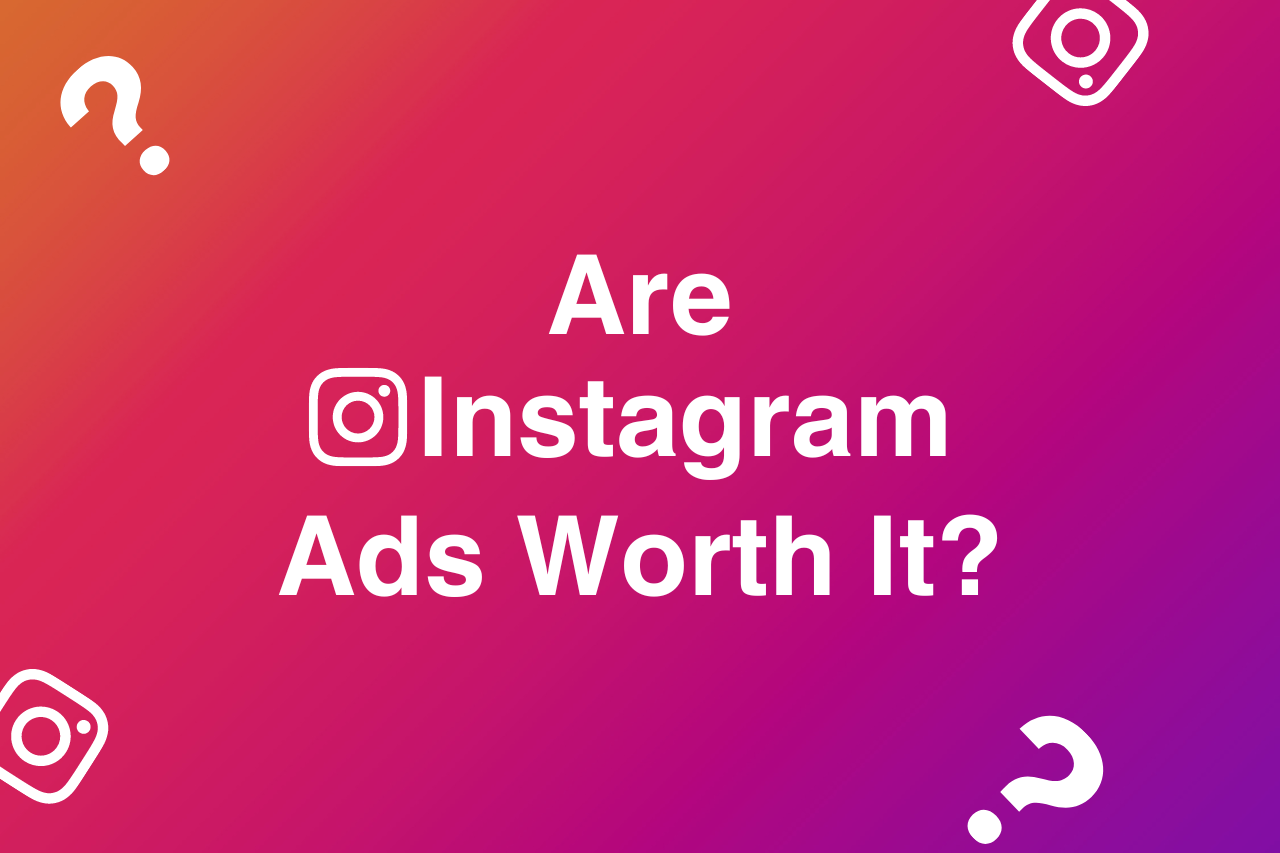
Are Instagram Ads Worth It? Understanding Cost, Engagement, and ROI: Maximizing Returns in Digital Advertising
Social media advertising is a key component of effective marketing strategies in today’s digital landscape. With its visually rich platform, Instagram stands out as a significant player, captivating a large audience with its dynamic content. Boasting over a billion active users, the potential reach of Instagram ads is extensive, offering businesses a unique opportunity to connect with their target demographic.
In this article, we’ll delve into the world of Instagram advertising, examining the cost of running ads, the level of engagement they can achieve, and, most importantly, the return on investment (ROI) they can provide. We aim to offer you a clear and straightforward analysis of whether investing in Instagram ads is a sound decision for your business.
Understanding Instagram Ads
Instagram ads come in various formats, each with its unique appeal. The most common types include:
- Stories Ads: Full-screen ads that appear between users’ Stories, offering a highly immersive experience.
- Feed Ads: Traditional ads that appear in the user’s main Instagram feed, seamlessly integrating with organic posts.
- IGTV Ads: Ads that appear when users watch IGTV videos, catering to an audience interested in longer-form content.
- Reels Ads: Short, engaging ads that appear in between users’ Reels, tapping into the platform’s newest and rapidly growing feature.
The relevance of Instagram ads in today’s digital marketing landscape is undeniable. With its visually driven content and diverse ad formats, Instagram provides a fertile ground for brands to showcase their products and services creatively and engagingly.
Additionally, the platform’s advanced targeting options allow advertisers to reach specific audiences based on demographics, interests, behaviors, and more. This precision in targeting, combined with the visual appeal of Instagram ads, makes them a crucial tool in any marketer’s arsenal.
Cost of Instagram Ads
The cost of Instagram ads isn’t a one-size-fits-all figure; it’s influenced by several factors:
- Target Audience: The competition for your target audience’s attention can influence the cost. Niches with high demand may have higher ad costs.
- Ad Format: Different ad formats can have varying costs. For example, Stories ads might be priced differently than Feed ads.
- Bidding Strategy: Whether you choose cost-per-click (CPC), cost-per-impression (CPM), or cost-per-engagement (CPE) bidding can affect your ad spend.
- Time of Year: Advertising costs can spike during peak shopping seasons or major events due to increased competition.
On average, businesses might expect the following cost metrics:
- Cost Per Click (CPC): $0.20 – $2.00
- Cost Per Impression (CPM): $3.00 – $10.00
- Cost Per Engagement (CPE): $0.01 – $0.50
To manage your ad spend effectively:
- Set Clear Objectives: Know what you’re aiming for (awareness, conversions, engagement), as this will guide your budgeting decisions.
- Test and Learn: Start with smaller budgets to test different formats and targeting options. Analyze what works best in terms of cost-efficiency and scale accordingly.
- Use Built-in Tools: Instagram’s ad manager provides insights and tools to help you optimize your campaigns and control spending.
- Monitor Regularly: Keep an eye on your campaigns’ performance and adjust bids, targeting, or creative as needed to ensure you’re getting the most out of your budget.
Understanding these aspects of Instagram advertising costs can help you make informed decisions, ensuring your investment brings the desired results without overspending.
Engagement through Instagram Ads
Engagement is the heartbeat of Instagram advertising, serving as a crucial metric to gauge the effectiveness of your ads. Unlike traditional advertising metrics that focus solely on reach or impressions, engagement encompasses how users interact with your ads—through likes, comments, shares, and saves.
This interaction not only signifies interest but also boosts your ad’s visibility on the platform, thanks to Instagram’s algorithm favoring content with higher engagement.
To craft ads that resonate and engage, consider the following strategies:
Leverage Eye-Catching Visuals: Instagram is a visual platform, so high-quality, captivating images or videos are paramount. Use vibrant colors, compelling compositions, and visuals that align with your brand identity to grab attention.
Refine Your Copy: While visuals draw them in, your copy hooks them. Keep your message clear, concise, and targeted. A compelling call-to-action (CTA) is essential—encourage users to engage by asking questions, prompting them to share their thoughts, or inviting them to learn more by clicking on your ad.
Target Wisely: Utilize Instagram’s targeting options to ensure your ads reach the people most likely to engage with them. Segment your audience based on demographics, interests, behaviors, and even retarget previous website visitors. The more relevant your ad, the higher the engagement.
Incorporate Interactive Elements: Features like polls in Stories or questions in captions can significantly increase engagement by encouraging direct interaction. These elements not only entertain but also invite users to participate in a conversation with your brand.
Test and Optimize: Engagement rates can vary greatly depending on the ad’s content, timing, and audience. Continuously test different elements of your ads, such as images, copy, and targeting criteria, to see what resonates best with your audience. Use Instagram’s analytics tools to track engagement metrics and refine your strategy accordingly.
By prioritizing engagement in your Instagram ad campaigns, you not only increase the likelihood of achieving your marketing objectives but also build a more meaningful connection with your audience.
ROI of Instagram Ads
In the world of Instagram advertising, Return on Investment (ROI) is the litmus test for success. It measures the efficiency of your ad spend, helping you understand whether the financial gains from your campaigns outweigh the costs. Essentially, a positive ROI means your advertising efforts are not only paying off but also contributing to your business’s growth.
Understanding and measuring ROI involves a few critical steps:
Track Conversions: The most direct way to gauge the effectiveness of your Instagram ads is by tracking conversions. This could be sales, leads, or any other action that aligns with your campaign goals. Setting up Instagram’s pixel on your website allows you to trace these conversions back to specific ads, giving you clear insight into their performance.
Analyze Ad Metrics: Instagram provides a wealth of data through its Insights and Ads Manager. Key metrics to focus on include click-through rate (CTR), cost per conversion, and overall engagement. These indicators help paint a picture of how well your ads are resonating with your target audience.
Use Analytics Tools: Beyond Instagram’s native tools, third-party analytics can offer deeper insights. Tools like Google Analytics or specialized social media marketing platforms enable you to track the customer journey more thoroughly, from ad clicks to conversion. This comprehensive view helps in understanding the broader impact of your Instagram ads on your business objectives.
Measuring ROI effectively requires consistent monitoring and a willingness to adjust strategies based on performance data. By understanding what works and what doesn’t, you can refine your approach to maximize returns, ensuring that every dollar spent on Instagram ads contributes to your business’s success.
Factors Affecting Ad Success
While cost, engagement, and ROI are crucial metrics, several other factors can significantly impact the success of your Instagram ads. Understanding these elements can help you fine-tune your strategy for better results.
Content Quality: The quality of your ad content is paramount. High-resolution images, compelling videos, and clear, concise messaging can make your ads stand out in a crowded feed. Invest in professional visuals and creative copywriting to capture your audience’s attention.
Audience Targeting: Precision in targeting is key to reaching the right people. Instagram offers robust targeting options based on demographics, interests, behaviors, and even lookalike audiences. Regularly review and adjust your targeting settings to ensure your ads are being seen by your ideal customers.
Ad Placement: Where your ads appear on Instagram can affect their performance. Test different placements (e.g., feed, Stories, Explore) to see where your ads resonate most. Each placement has its unique characteristics and user behaviors, so understanding these nuances can help optimize your ad strategy.
Timing: The timing of your ads can influence their success. Consider factors such as the time of day, days of the week, and even seasonal trends. Analyzing when your audience is most active on Instagram can help you schedule your ads for maximum visibility and engagement.
By paying attention to these factors and continuously refining your approach based on performance data, you can enhance the effectiveness of your Instagram ads and achieve better outcomes for your business.
Conclusion
In this article, we’ve unpacked the intricacies of Instagram advertising, from the costs involved to the engagement they can drive and the ROI they can deliver. We’ve also touched on the various factors that can influence ad success, such as content quality, audience targeting, and ad placement.
So, are Instagram ads worth the investment? The answer largely depends on your business goals, target audience, and budget. When executed well, Instagram ads can offer significant returns, driving both brand awareness and conversions. However, it’s essential to approach them with a strategic mindset, continuously optimizing based on performance data.
As you consider diving into Instagram advertising, reflect on your specific objectives and resources. With the right strategy in place, Instagram ads can be a valuable addition to your marketing arsenal, helping you reach and engage your desired audience in a dynamic and visually compelling way.



